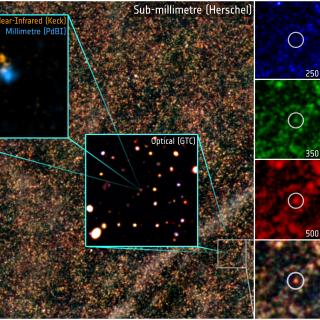Bibcode
Berta, S.; Young, A. J.; Cox, P.; Neri, R.; Jones, B. M.; Baker, A. J.; Omont, A.; Dunne, L.; Carnero Rosell, A.; Marchetti, L.; Negrello, M.; Yang, C.; Riechers, D. A.; Dannerbauer, H.; Perez-Fournon, I.; van der Werf, P.; Bakx, T.; Ivison, R. J.; Beelen, A.; Buat, V.; Cooray, A.; Cortzen, I.; Dye, S.; Eales, S.; Gavazzi, R.; Harris, A. I.; Herrera, C. N.; Hughes, D.; Jin, S.; Krips, M.; Lagache, G.; Lehnert, M.; Messias, H.; Serjeant, S.; Stanley, F.; Urquhart, S.; Vlahakis, C.; Weiß, A.
Bibliographical reference
Astronomy and Astrophysics
Advertised on:
2
2021
Journal
Citations
32
Refereed citations
30
Description
Exploiting the sensitivity of the IRAM NOrthern Extended Millimeter Array (NOEMA) and its ability to process large instantaneous bandwidths, we have studied the morphology and other properties of the molecular gas and dust in the star forming galaxy, H-ATLAS J131611.5+281219 (HerBS-89a), at z = 2.95. High angular resolution (0.″3) images reveal a partial 1.″0 diameter Einstein ring in the dust continuum emission and the molecular emission lines of 12CO(9-8) and H2O(202 - 111). Together with lower angular resolution (0.″6) images, we report the detection of a series of molecular lines including the three fundamental transitions of the molecular ion OH+, namely (11 - 01), (12 - 01), and (10 - 01), seen in absorption; the molecular ion CH+(1 - 0) seen in absorption, and tentatively in emission; two transitions of amidogen (NH2), namely (202 - 111) and (220 - 211) seen in emission; and HCN(11 - 10) and/or NH(12 - 01) seen in absorption. The NOEMA data are complemented with Very Large Array data tracing the 12CO(1 - 0) emission line, which provides a measurement of the total mass of molecular gas and an anchor for a CO excitation analysis. In addition, we present Hubble Space Telescope imaging that reveals the foreground lensing galaxy in the near-infrared (1.15 μm). Together with photometric data from the Gran Telescopio Canarias, we derive a photometric redshift of zphot = 0.9-0.5+0.3 for the foreground lensing galaxy. Modeling the lensing of HerBS-89a, we reconstruct the dust continuum (magnified by a factor μ ≃ 5.0) and molecular emission lines (magnified by μ ∼ 4 - 5) in the source plane, which probe scales of ∼0.″1 (or 800 pc). The 12CO(9 - 8) and H2O(202 - 111) emission lines have comparable spatial and kinematic distributions; the source-plane reconstructions do not clearly distinguish between a one-component and a two-component scenario, but the latter, which reveals two compact rotating components with sizes of ≈1 kpc that are likely merging, more naturally accounts for the broad line widths observed in HerBS-89a. In the core of HerBS-89a, very dense gas with nH2 ∼ 107 - 9 cm-3 is revealed by the NH2 emission lines and the possible HCN(11 - 10) absorption line. HerBS-89a is a powerful star forming galaxy with a molecular gas mass of Mmol = (2.1 ± 0.4) × 1011 M⊙, an infrared luminosity of LIR = (4.6 ± 0.4) × 1012 L⊙, and a dust mass of Mdust = (2.6 ± 0.2) × 109 M⊙, yielding a dust-to-gas ratio δGDR ≈ 80. We derive a star formation rate SFR = 614 ± 59 M⊙ yr-1 and a depletion timescale τdepl = (3.4 ± 1.0) × 108 years. The OH+ and CH+ absorption lines, which trace low (∼100 cm-3) density molecular gas, all have their main velocity component red-shifted by ΔV ∼ 100 km s-1 relative to the global CO reservoir. We argue that these absorption lines trace a rare example of gas inflow toward the center of a galaxy, indicating that HerBS-89a is accreting gas from its surroundings.
The reduced datacubes are only available at the CDS via anonymous ftp to http://cdsarc.u-strasbg.fr (ftp://130.79.128.5) or via http://cdsarc.u-strasbg.fr/viz-bin/cat/J/A+A/646/A122
Related projects

Formation and Evolution of Galaxies: Observations in Infrared and other Wavelengths
This IAC research group carries out several extragalactic projects in different spectral ranges, using space as well as ground-based telescopes, to study the cosmological evolution of galaxies and the origin of nuclear activity in active galaxies. The group is a member of the international consortium which built the SPIRE instrument for the
Ismael
Pérez Fournon

Molecular Gas and Dust in Galaxies Across Cosmic Time
Two of the most fundamental questions in astrophysics are the conversion of molecular gas into stars and how this physical process is a function of environments on all scales, ranging from planetary systems, stellar clusters, galaxies to galaxy clusters. The main goal of this internal project is to get insight into the formation and evolution of
Helmut
Dannerbauer